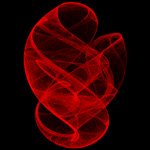|
Scientific phenomenon has an artistic aesthetic that transcends its ability to attempt to explain the world around us.
Color records time and creates the illusion of dimensionally.
Science is always searching for predictability. For example, when will the next solar eclipse occur? Science can predict the exact time and also tell us where on earth the best place to view it is. Scientific theory relies on whether predictions are supported by observation. These theories rely on relationships that are deterministic; given a present condition, a future event can be determined.
Much in our environment can not be predicted. The arrangement of molecules in our brain does not determine our behavior. Each cloud is different, even if they are at the same altitude and under the same climatic conditions. A flower evolves slowly over time due to growing conditions or may become extinct. We are also evolving as our earthly environment changes in ways we can not predict.
Then we come to what has been dubbed the butterfly effect. Is it possible for a butterfly flapping its wings in Brazil to set off tornadoes in Texas? Even though the weather is governed by the atmosphere, and the atmosphere obeys deterministic physical laws, long range accurate weather reporting still has much to be improved, even though we now have great amounts of observations and incredible computer resources for analysis and simulation.
Unpredictable behavior of deterministic systems has been called chaos, a term introduced by Tien-Yien Li and James A. Yorke in 1975. Strange attractors first appeared in 1971 by David Ruelle and Floris Takens, as related to the nature of turbulence and the patterns that were produced.
Chaotic processes are not random; they follow rules, but even very simple rules can produce extreme complexity. This complexity can be expressed as a series of equations or visualized and rendered when the element of time as color is introduced into its interpretation. The mathematics of chaos provides the tools for creating and displaying such phenomenon.
Time becomes color.
Strange attractors generate repeating point patterns in two-dimensional space while their coloring algorithms which represent time can produce images of coherent three-dimensional forms. The third dimension is determined by the perception of the viewer coupled with a created intent. The forms include a ghostly view into an imaginary core. The swirling patterns gently display possible subsurface structures that cannot be logically followed through any dimension. Dimensions become ambiguous as your perception attempts to combine the individual points so they complete a whole, one that is devoid of context.
The value of the color, red, ranges from early time, nearly black, to recent time, bright red. Color is used to denote time and its aggregation creates the illusion of dimensionally in the images.
Structured, unstructured; visible, invisible; logical, illogical; perfect, imperfect; intentional, unintentional; two-dimensional, three-dimensional. An unpredictable assembly of scattered points congregates into perceptual patterns. Our visual perception overrides any logical order we wish to establish. Color causes the crossover of dimesnion.
Many of these could have been inspired from natural forces such as, wind and water, or earthen formations. For example, the stone series explores the possible subsurface patterns in nature that are not visible to us; the smoldering images smoke, others; folding, bending, twisting, draping and crumpling of identifiable materials or organisms.
These images were created algorithmically using a series of related strange attractor equations with coloring schemes that bring out the time element of the computational process. Each was developed by the computation of between twelve-to-fifty-seven million points. A total of 24,000 images were generated from twenty-four equations. Each image was reviewed and then approximately 200 were selected for rendering.
[The first part of this introduction was taken from “Strange Attractors, Creating Patterns in Chaos” by Julien C. Sprott, 1993, M&T; Books.]
|




